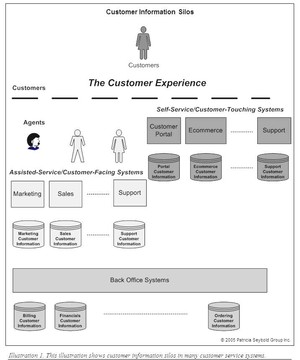Federated Customer Information
A Practical Approach to Breaking through Customer Information Silos
Customer information is the key to delivering the kind of personalized cross-channel, cross-lifecycle customer experience that makes it easy for your customers to do business with you. It’s the information that identifies your customers and comprehensively represents their relationships with you. Without customer information, you can’t do business. The problem is that you have too much customer information. Some of it is managed in all of your customer-touching and -facing systems. In this report, we describe a best practices approach for harnessing customer information.
NETTING IT OUT
Customer information is the key to delivering the kind of personalized cross-channel, cross-lifecycle customer experience that makes it easy for your customers to do business with you. Your customers and customer service agents need access to the data that identify your customers and the information that comprehensively represents their relationships with you. Without access to customer data and information, you can’t do business.
The problem is that you have too much customer information. Some of it is managed in each of your customer-touching and -facing systems. You’ve got to harness it to support your customer’s cross-channel, cross-lifecycle activities.
How can you harness all of your customer information? Hint: A CRM system is probably not the answer and the answer may not lie in the implementation of an Operational Data Store (ODS) or a customer data warehouse, either. A CRM system is yet another source of customer information and a source designed to support your sales activities, not your customer activities. You probably don’t have the time or resources to build and manage an ODS and/or customer data warehouse if you haven’t got one already.
The best practices solution is to access the customer data that you need when you need it, getting billing information into your customer portal or incident histories into your customer service system, for example. We call this approach federated customer information. To be successful with it, you’ll need to have people in your organization who are willing to share customer information. You’ll also need the technologies that allow you to access, move, transform, and integrate customer information into context where it’s needed
THE CUSTOMER INFORMATION PROBLEM
A Holistic, Context-Appropriate Customer View Is Essential
You probably have too much customer information. There’s some of it used in every system that supports your customers’ interactions with your business--campaign management systems, ecommerce systems, and customer service systems, for example. There’s also customer information in every system that records your customers’ transactions and behavior--order management, billing, and data warehousing systems, for example.
These individual systems are your collection of customer information silos or customer information islands. None takes the perspective of your entire customer experience. None of them takes a cross-channel, cross-lifecycle perspective of your customer relationships. These silos and islands prevent you from having a single view of your customers or a 360-degree view of their relationships with you.
You don’t always need that grand view. What’s more important is a context-appropriate, holistic view of a customer’s relationship with you, and you need that view for many types of interactions. For example, the holistic, context-appropriate view of customer information for a self-service billing inquiry requires this customer data:
- Details of current bill
- Billing history
- Payment details and payment history
- Order details and order history (to enable customers to drill into line items on a bill)
- The ability for customers to assign categories to billing details so they can sort, organize and subtotal by geography, department, or other customer-specific classification scheme.
You Have Application-Specific Customer Information Silos and Islands
From this billing example, you can see that your customers need this kind of holistic, context-appropriate perspective to do business with you. You need it too in order to service and support them. But your implementation––more precisely, your many implementations of customer data––make it very difficult to create this view. The points below describe what we mean. Illustration 1 shows the problem visually.
Customer Information Silos

Illustration 1. This illustration shows customer information silos in many customer service systems.
* Your ecommerce systems might not share customer preference information or outbound communications data with your campaign management system. As a result, you might be making conflicting or redundant offers, or you might be inundating and annoying your customers with too many offers.
* Your billing systems might not share customer information with your incident management system. So, you might be threatening a customer with discontinuing a service that has never been successfully activated.
* You have separate customer service systems for self-service and for assisted service. When your customers can’t help themselves to solve problems, you force them to retell their story to your agents who instruct them to repeat the diagnostic steps that they’ve already taken. You waste their time and you waste your agents’ time.
* In your Web systems, you let your customers access and update the information that you manage about them--names, addresses, user IDs and passwords, alerts, and so on. This is great except that you maintain independent profiles in your Web site, your ecommerce system, and your customer service system. The customer information in them is out of synch and out of date. You have no idea which is accurate.
See what we mean by customer information silos? Within each of them you may have a have great single channel, or single lifecycle phase, or single lifecycle activity views of your customers, but their existence makes it hard to create holistic, context-appropriate views.
Let’s take a step back and try to describe the nature of the problem in order to be able to suggest a coherent solution to it...
Sign in to download the full article
0 comments
Be the first one to comment.



